![]()
![]()
![]()
Use LEFT and RIGHT arrow keys to navigate between flashcards;
Use UP and DOWN arrow keys to flip the card;
H to show hint;
A reads text to speech;
89 Cards in this Set
- Front
- Back
|
What innervates the central auditory pathway? |
Auditory nerve (VIII) |
|
|
What are the two streams of the Central Auditory Pathway? |
Ventral and Dorsal |
|
|
Recite the ventral central auditory pathway |
auditory nerve --> synpase on ventral cochlear nucleus --> secondary afferent fibres split -> reach left AND right of superior olive in pons --> lateral lemniscus in pons --> inferior colliculi in midbrain--> medial geniculate nucleus in thalamus --> primary auditory cortex |
|
|
What does the ventral auditory pathway do? |
Determines the timing information about auditory input. Specifically, the biaural input at the superior olives gives us the interaural difference to determine timing and where sound is coming from. |
|

What is this image? |
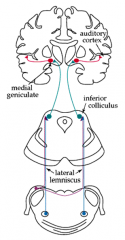
ventral auditory pathway bottom cut: pons --> superior olives and lateral lemniscus middle cut: midbrain --> inferior colliculus top cut: brain: medial geniculate and primary auditory dortex |
|
|
Recite the dorsal stream of the central auditory pathway |
Auditory nerve (III) synapses on the dorsal cochlear nucleus --> the secondary afferents split--> go on the the lateral lemniscus in pons --> inferior colliculi (in midbrain) --> medial geniculate nuclei (in thalamus) --> primary auditory cortex for processing |
|
|
What does the dorsal stream of the central auditory system do? |
It determines sound quality (hence it doesn't go synapse on the superior olives) Differences in frequencies determine different sound quality |
|
|
Explain tonotopic organization |
Sound frequency input that enters the central auditory pathway is organized exactly the same in the primary auditory cortex |
|
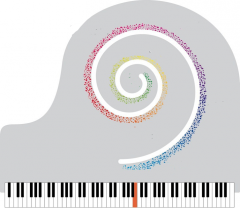
Where are the low frequenices? In what region? Where are high frequenices? In what region? |
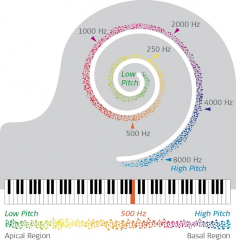
-Cochlea -Low is In middle in the apical region High is in the outsie in the basal region -The cochlea is where hairs pick up on the different frequenices |
|
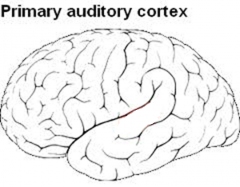
Where is it? |
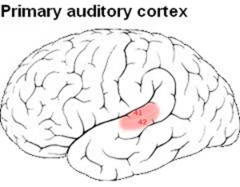
Here it is! |
|
|
Where does the auditory cortex lead to? |
Superior temporal gyrus |
|
|
What happens when there's damages to hair cells in one frequency range? |
Neighboring hair cells pick up |
|
|
What is tinnitus? |
High frequency ringing of buzzing in the ears; brain could be manufacturing sounds to replace missing input |
|
|
What is the heirarchy of executive functions you must go thru before a decision is made? |
1. alertness 2. attention 3. memory 4. retrieval 5. decision making |
|
|
What is the reticular formation? |
A series of loosely arranged nuclei in the medulla, pons, and midbrain with ASCENDING and DESCENDING fibers |
|
|
Where is the reticular formation located? |
In the tegmentum--pons, medulla, and midbrain |
|
|
What is the reticular formation involved with? |
Proprioceptive, pain, and autonomic processes |
|
|
Where do the descending fibers go? |
-Originate in the reticular formation with nuclei in the medulla -Travel downwards and connect to cerebellum, sensory system, and vital systems (like respiratory or cardiac) |
|
|
What are the descending fibers of the reticular formation responsible for? |
Sensory information but also autonomic functions such as heartbeat, respiration |
|
|
Where do the ascending fibers go? |
-Nuclei in pons and midbrain -Connect to the thalamus, hypothalamus, and cortex |
|
|
What does RAS stand for? |
Reticular Activating System |
|
|
What forms the RAS? |
Ascending fibers from the reticular formation |
|
|
What do ascending fibers of reticular fomraiton do? |
-Form the RAS -Involved in alertness, wakefullness, consciousness, and arousal |
|
|
Lesion to the descending fibers of the reticular formation would lead to...? |
DEATH |
|
|
Lesion to the ascending fibers of the reticular formation would lead to...? |
Lack of consciousness, coma, person still alive Mike the Headless Chicken tbh |
|
|
What stimulates the RAS? |
Incorporates sensory information (visual, auditory, and pain stimuli) Cognitive stimulsu |
|
|
What would the removal of visual or auditory stimulus lead to in terms of alertness? |
Drowsiness bc of a lack of sensory stimulation |
|
|
How can irritants stimulate the RAS? |
Trigeminal nerve |
|
|
What are risk factors to RAS functioning? |
Preterm birth, leads to deficits in sleep-wake cycle, arousal, an attention Prenatal nicotine exposure leads to deficits in arousal and attention |
|
|
Look at the recommendations of talking to someone in a coma |
Coma not a passive state bc still EEG activity |
|
|
What areas are implicated in attention? And how do they work with attention? |
The 1) sensory system picks up on stimuli/environmental experiences and does preprocessing for attention, such that you can choose to attend to certain environmental stimuli. There is a 200 - 500 ms time period that this information is held onto 2) Prefrontal cortex - The prefrontal cortex makes the decision whether or not to pay attention to a stimulus picked up by the sensory system and allocates cognitive resources if the choice is made to attend |
|
|
Types of Attention, describe, and give example |
1. Focused Turning head if someone opens door 2. Sustained A security guard watching a monitor for hours on end 3. Selective Studying in a busy coffee shop and focusing in on your notes amongst the noise 4. Alternating Making flashcards and watching TV hehe |
|
|
Who made the hierarchy of attention? |
Scholberg & Mateer |
|
|
What are the parts of memory? Describe each. |
1. Encoding/Learning Acquiring new information and forming neurological connections to aid in their retention 2. Retention/storage Retaining information through organization and associations 3. Retrieval Calling upon information using organization Recognition and production (?) 4.Forgetting Failure of memory |
|
|
What are the stages of memory? |
Sensory Short Term Long Term Remote |
|
|
What is sensory memory? |
Part of memory that takes in sensory input; this input is there for about 1 or 2 seconds and the brain's prefrontal cortex makes a decision to attend to this information or not! |
|
|
What is short term memory? |
A few minutes Can hold up to 7+/-2 chunks Is aided by chunking (phone #s) Basically holds information for a small amount of time |
|
|
What is working memory? |
A subset of Short Term Memory Involves the visuospatial sketchpad, phonological loop, and central executive A shifting window of attention that live processes |
|
|
What is the phonological loop? |
Part of the working memory, it is the auditory memory that is held onto for 0-30 seconds. |
|
|
What is the visuospatial sketchpad? |
Part of the working memory, it is the visual memory that is held onto for 0-30 seconds |
|
|
What is the central executive? |
Part of the working memory, it is the prefrontal cortex deciding whether or not to allocate resources and attention |
|
|
What is the significance of chunking? |
Chunking facilitates one's memory. Chunks vary in length and complexity. The STM can hold 7+/- 2 chunks but incr complexity allows for less chunks because pressure on cognitive load. |
|
|
What is Long Term Memory (LTM)? |
Long Term Memory is memory that is retained for longer than minutes |
|
|
What are the two main types of LTM? (long term memory) |
Explicit (declarative) and Implicity (Procedural) |
|
|
What is explicit or declarative memory? What are the subtypes? |
Explicit memory is memories you can consciously recall. Episodic - remembering episodes of your life Semantic - remembering general knowledge |
|
|
What is implicit or procedural memory? |
Memory you can't consciously recall. For example, Pavlov's dog (conditioned memory) or proecdures and skills (how to drive) |
|
|
What is remote memory? |
Memories from the distant past, intact in dementia |
|
|
Types of retrieval |
1. recall 2. recollection 3. recognition 4. relearning |
|
|
What is recall? What are types? |
Recall: regeneration of a memory Free recall: regenerate memory without cue (essay question) Cued recall: regenerate memory with cue |
|
|
What is recollection? |
The regeneration of a memory based off the logical organization of the brain's partial memories and cues |
|
|
What is relearning? |
If a stimulus is experienced again, forgetting and having to learn once again |
|
|
What is organization's role in retrieval? |
Need organization to encode and retrieve memories in a more efficient way Memory is often organized into categories, as such, retrieval is easier if you stay within category (ex: if you're doing an animal naming activity, if you say cow, you would easily say other farm animals next such as pig, horse, etc. quicker than naming a non-farm animal) |
|
|
What areas (anatomically) are involved in memory? |
-hippocampus -mammilary bodies -prefrontal (medial and orbital surfaces) -thalamus |
|
|
What does the hippocampus do, in the context of memory? What happens if it incurs damage? |
Contains long-term storage and processing Damage leads to anterograde amnesia |
|
|
What are the mammilary bodies? |
They are the relay station for memory |
|
|
What is the prefrontal cortex-medial and orbital surfaces? What happens if damaged |
Organize memories Damage leads to confabulation |
|
|
What is the thalamus? |
Serves as relay station for sensory memory, connects to thalamus |
|
|
What is confabulation? |
Stringing together memory in an unorganized way, false retelling without consciously decieving someone; misinterpreted or distorted memory |
|
|
What is repetition's role in memory?
|
-Repetition can strengthen memory, because "retelling" a story will strengthen neurological connections over time. -Others argue that repetition can threaten the integrity of a memory. By retelling a story, pieces of memory could be merged together, producing a false narrative or certain phrasing can shift certain nuances in memory by extension. Basically, memory is more vulnerable to changes as you pull it out |
|
|
Explain storage in memory |
Storage in memory is not all in one place and instead scattered, it's probably organized by associative areas |
|
|
What is the circuit of Papez? |
Neural circuit Subset of limbic system interconnections Leads to eventual memory consolidation |
|
|
What is the flow of the circuit of Papez? |
Fornix --> move anteriorally and medially until at mammilary bodies --> from the mammilary bodies, go to anterior thalamic nuclei (in thalamus) via the mammilothalamic tract --> from the anterior thalamic nuclei --> internal capsule --> cingulate gyrus --> moves posteriorly along to parahippocampal gyrus via the entorhinal cortex --> hippocampus --> MEMORY CONSOLIDATED |
|
|
Describe characteristics of amnesia |
(-) consolidation of memories and (-) retrieval Different types of memory affected differently, either can't recall old memories or can't form new ones STM in tact Effects episodic memory most Caused by damaged to medial temporal lobes and hippocampus |
|
|
Types of amnesia |
retrograde anterograde global post-traumatic |
|
|
Causes of amnesia? |
Stroke, TBI, Infection, Alcoholism, |
|
|
What are the areas that form the neurological basis of language? |
-primary auditory cortex -Wernicke's -Angular gyrus -Arcuate fasiculus -Broca's -Supramarginal gyrus -primary motor -corpus caollosum -subcortical areas |
|
|
Primary auditory or visual cortex |
Provides input of written, signed, or spoken word for language processing |
|
|
Wernicke's area |
Converts sound into language |
|
|
Angular gyrus |
Converts words into language -dyslexia |
|
|
Arcuate fasiculus |
Links Broca's and Wernicke's Is involved with repetition |
|
|
Broca's area |
Organization of speech production -Connects to ~motor~ |
|
|
Supramarginal gyrus |
Writing integration |
|
|
Primary motor |
Activates areas for speech, voice, or signs |
|
|
Corpus callosum |
Interhermispheric communication, connects left and right language structures |
|
|
Subcortical areas (thalamus, striatum, etc.) |
Regulated, gated feedback loop |
|
|
Language on the left |
Analytical for speech sounds Grammatical processing LOCAL Decoding patterns and systems |
|
|
Language on the right |
GLOBAL
Grand integrater Prosody Integration of different stimulus types Arousal/alertness/attention |
|
|
Language deficits if damage on left hemisphere |
Anomia Aphasia Dyslexia/dysgraphia Spoken/signed/written word deficit |
|
|
Language deficits if damage on right hemisphere |
Lack of initiation Can't decode speaker's emotional state Can't integrate face, voice, body, & words |
|
|
Clues to language processing |
-Priming -Category specific language subdivisions -Meaningful context |
|
|
Priming |
Semantic Phonetic Functional deactivation |
|
|
Category specific language subdivisions
|
animate vs. inantimate category specific deficits in aphasia imageable words dual coding theory |
|
|
meaningful context |
sounds vs. words isolated words vs. sentences |
|
|
Aphasia |
Acquired cmmxn disorder Comprehension, expression, or botoh affected often reading and writing disrupted often due to cerebrovascular accident (CVA) |
|
|
Broca's aphasia |
Lack of fluency Comprehension fine Effortful, poorly articulated content words often preserved, functional words not |
|
|
Wernicke's |
Lack of processing language input (aka problems with comprehension) Fluency fine Can't monitor language output |
|
|
Factors affecting aphasia outcomes |
Severity of lesion Cause of lesion Location of lesion Cerebral blood flow Intensity of Speech Language Therapy |
|
|
Treatment Options for CVA |
Surgery, Cerebral Angioplasty, tPA |
|
|
High intensity early intervention |
Highly effective After CVA, neural connections would be messed up due to the condition, rewire brain's framework (neuroplasticity) for neurons to allow connections again |

